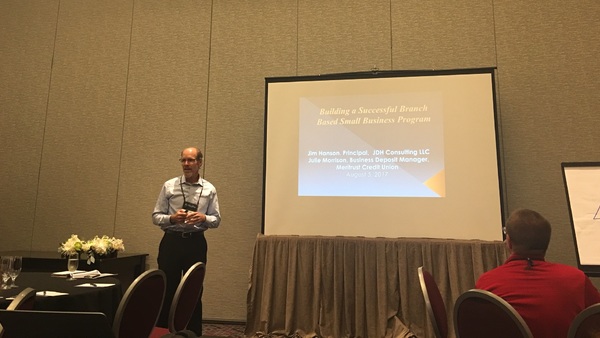 Jim Hanson of JDH Consulting discusses why credit unions should implement a branch-based small business program.
Jim Hanson of JDH Consulting discusses why credit unions should implement a branch-based small business program.PORTLAND, Ore. – Despite the perception that small business owners wouldn’t think of looking to credit unions for financial services, credit unions could be their perfect partners. And by setting up successful branch-based small business programs, a small business member base can lead to excellent returns for cooperatives.
That’s according to Jim Hanson, principal consultant for JDH Consulting, LLC in Tucson, Ariz., who spoke to credit union executives at the 2017 CUBG Annual Conference Wednesday in a breakout session, “Building a Successful Branch-Based Small Business Program.” His co-speaker was Julie Morrison, business deposit manager at the $1.3 billion Meritrust Credit Union in Wichita, Kan., whose credit union saw growth after implementing Hanson’s program.
“Small business owners love walking into branches and dealing with the person who can help them solve their problems,” Hanson said. “Another thing that works to our advantage is that they hate big banks.”
What’s more, Hanson said, the number of community banks has shrunk in recent years, leaving less competition for credit unions in the small business banking space.
According to Hanson, implementing a branch-based small business program leads to positive repercussions for the credit union as a whole. These benefits include:
- A minimal investment, as credit unions can utilize their existing branch staff to serve small business members;
- A reduced number of branch bottlenecks at the new accounts desk and improved member service levels over time;
- More and better quality credit referrals to the business lending department;
- The ability to free up time for the business lending department to focus on larger, more complex and profitable deals;
- An increase in new member accounts, credit cards, loans and deposits; and
- Free marketing and brand awareness.
Under a branch-based small business program like Hanson’s, credit unions become proactive as opposed to reactive when building a small business member base. Hanson said when a reactive approach is taken, credit unions see an average of two new small business members per month; those members hold an average balance of $1,159 and 1.5 products, and close their account within six to 10 months, resulting in an average profit of just $6.57 for the credit union.
Once a credit union implements a proactive program, however, business specialists (who are typically existing credit union employees trained to handle small business accounts) will schedule weekly meetings with new and existing small business members, discover and recommend products to fulfill small business members’ unmet needs, and follow up with members to ensure their expectations are being met. This approach leads to the following averages for each small business member: An account balance of $13,698, 3.9 products, an account that stays open for 24 months or longer, and a profit of $171 for the credit union.
Hanson added the keys to a successful branch-based small business program include gaining support from and alignment with senior management, understanding the link between consumer and business financial services and that they support one another, establishing program success measures and expectations, and training specialists in branches that offer the most opportunity.
He also gave an example of how small business services became organically infused in the entire organization’s culture during one credit union’s implementation of his program.
“In the beginning, we were looking for any opportunity to have conversations,” he said. “As you go forward, people will start talking, and what I found was in the fourth quarter, the marketing department wanted to play, and wanted to update the website [with business services]. By then, the branches were absolutely engaged.”
Morrison noted that after implementing Hanson’s program, Meritrust saw big results in one year’s time: A jump in new business checking accounts from 149 in Q2 2016 to 228 in Q2 2017 (a 53% change) and an increase in new business memberships from 139 in Q2 2016 to 192 in Q2 2017 (a 38% change).
“I was very pleased,” Morrison said. “I didn’t even believe these numbers.”


